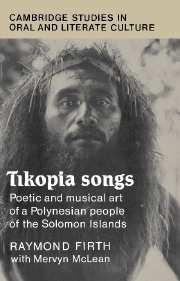Book contents
- Frontmatter
- Contents
- ILLUSTRATIONS
- FIGURES
- Preface
- Acknowledgements
- Sketch map of Tikopia (approx. 5 sq. km.)
- Part I General
- Part II Musical analysis (by Mervyn McLean)
- Part III Song texts, translations and commentary
- 6 Dance songs of everyday life
- 7 Songs of the sea and of travel
- 8 Eulogies and farewells
- 9 Songs of protest and criticism
- 10 Songs of erotic arousal and sex antagonism
- 11 Laments and funeral dirges
- 12 Songs on historical and mythic themes, and of ritual quality
- 13 Epilogue
- Appendix 1 Composers to whom songs attributed
- References
- Index
6 - Dance songs of everyday life
Published online by Cambridge University Press: 07 May 2010
- Frontmatter
- Contents
- ILLUSTRATIONS
- FIGURES
- Preface
- Acknowledgements
- Sketch map of Tikopia (approx. 5 sq. km.)
- Part I General
- Part II Musical analysis (by Mervyn McLean)
- Part III Song texts, translations and commentary
- 6 Dance songs of everyday life
- 7 Songs of the sea and of travel
- 8 Eulogies and farewells
- 9 Songs of protest and criticism
- 10 Songs of erotic arousal and sex antagonism
- 11 Laments and funeral dirges
- 12 Songs on historical and mythic themes, and of ritual quality
- 13 Epilogue
- Appendix 1 Composers to whom songs attributed
- References
- Index
Summary
The first parts of this book have given a general analysis of the social and musical nature of Tikopia song, its poetics, its typology, its structure and the occasions and manner of its use. In the following chapters I adopt a more thematic approach, considering the content of each song in its concrete and symbolic connotations, and giving where possible some detail about its composition and performance. For this purpose, though some chapters such as chapter 10 cite only mako and others such as chapter 11 cite almost entirely fuatanga, the classification is primarily not by type of song but rather by the subject to which it is addressed.
Many dance songs celebrate matters of interest to Tikopia in everyday life - natural phenomena such as rain beneficial to crops, the performance of craft work, the behaviour of birds and offish, the attraction of aromatic leaves and flowers admired for bodily decoration, the pleasures of institutionalised recreation such as the dart match and especially dancing itself. Even within the celebration of such mundane affairs human interest and human commitment have had play. So some of these songs do not merely take everyday objects or actions as theme, but use the theme to convey some personal attitude, expressing strong passions of joy or grief, praise or blame, wonder or fear.
However, the general thrust of many Tikopia songs is descriptive and action oriented rather than analytical of personality.
- Type
- Chapter
- Information
- Tikopia SongsPoetic and Musical Art of a Polynesian People of the Solomon Islands, pp. 127 - 141Publisher: Cambridge University PressPrint publication year: 1991



